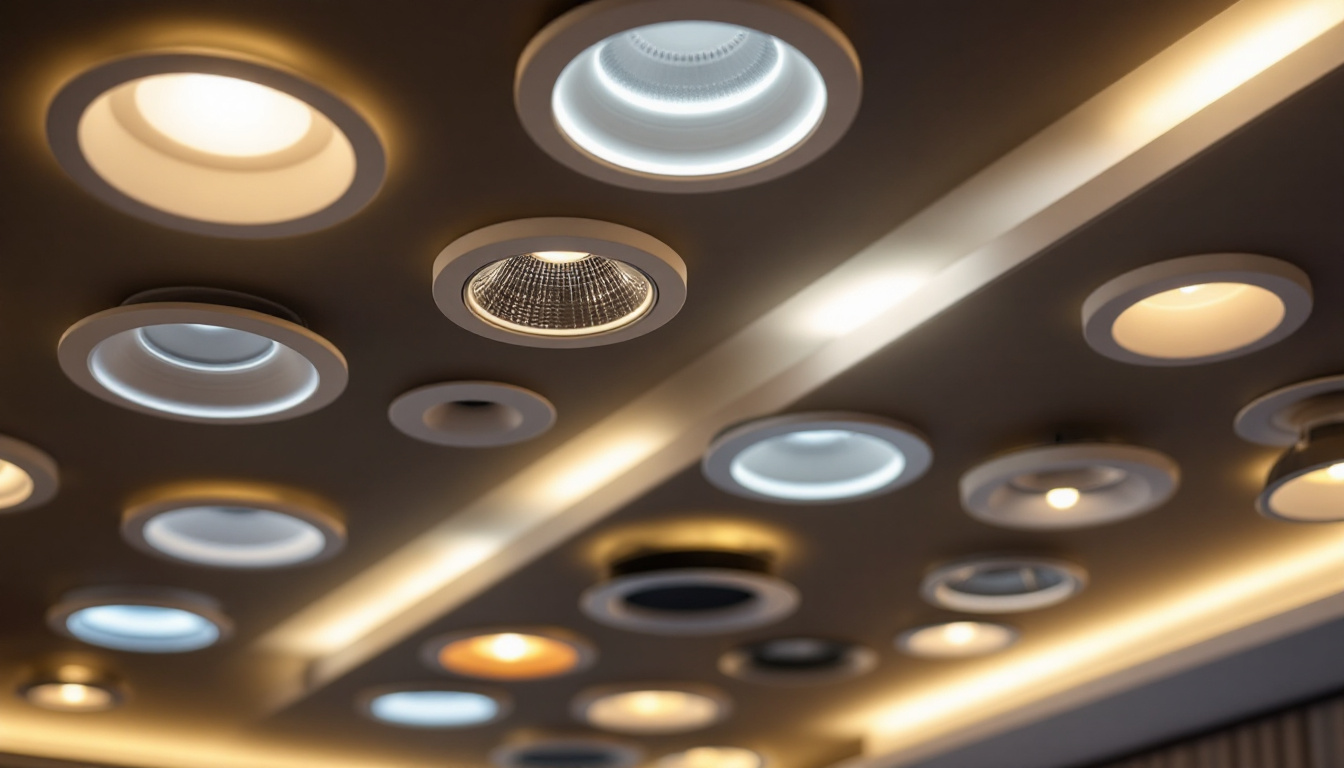
As the demand for modern and efficient lighting solutions continues to grow, recessed lighting has emerged as a popular choice among homeowners and designers alike. For lighting contractors, understanding the nuances of recessed light trim is essential for delivering high-quality installations that meet client expectations. This article delves into the various aspects of recessed light trim, providing valuable insights for lighting professionals.
Recessed lighting, often referred to as can lighting or downlighting, involves fixtures that are installed into the ceiling, creating a clean and streamlined appearance. This type of lighting is ideal for various applications, including residential, commercial, and retail spaces. The trim, which is the visible part of the fixture that surrounds the light bulb, plays a crucial role in both aesthetics and functionality. Recessed lighting can enhance the overall ambiance of a room, providing a modern touch while also serving practical purposes such as illuminating work areas or highlighting specific features within a space.
When it comes to recessed light trim, there are several types to consider, each offering unique features and benefits. The most common trims include:
Selecting the appropriate trim for a specific project requires careful consideration of various factors. Lighting contractors should evaluate the following:
Another important aspect to consider when selecting recessed lighting is energy efficiency. With the rise of LED technology, many homeowners are opting for LED recessed lights, which not only consume less energy but also have a longer lifespan compared to traditional incandescent bulbs. This shift not only contributes to lower electricity bills but also reduces the frequency of bulb replacements, making it a practical choice for both residential and commercial applications. Furthermore, LED options are available in a variety of color temperatures, allowing for greater customization of the lighting atmosphere to suit different moods and activities.
Finally, installation considerations play a significant role in the overall effectiveness of recessed lighting. Proper placement is key to achieving the desired lighting effect, and it is advisable to work with a qualified electrician to ensure that fixtures are installed at the correct spacing and angle. Additionally, the use of dimmer switches can enhance the versatility of recessed lighting, allowing users to adjust the brightness according to their needs and preferences. This flexibility can transform a space from bright and functional during the day to soft and inviting in the evening, showcasing the true potential of recessed lighting in any setting.
Proper installation of recessed light trim is vital for ensuring optimal performance and safety. Lighting contractors must adhere to best practices to achieve the best results.
Before installation, it is essential to assess the electrical requirements for recessed lighting. This includes checking the wattage of the bulbs and ensuring that the circuit can handle the load. Additionally, contractors should be aware of local electrical codes and regulations to ensure compliance. It is also advisable to consider the type of dimmer switches that will be used, as not all dimmers are compatible with LED bulbs. This compatibility can affect the overall performance and lifespan of the lighting system. Furthermore, ensuring that the wiring is properly insulated and secured can prevent potential hazards such as overheating or electrical shorts.
The placement and spacing of recessed lights significantly impact their effectiveness. A general rule of thumb is to space fixtures approximately 4 to 6 feet apart, depending on the wattage and beam spread of the bulbs used. In areas with higher ceilings, such as vaulted spaces, contractors may need to adjust the spacing to achieve the desired illumination. Additionally, it is important to consider the purpose of the lighting in each area; for instance, task lighting in kitchens may require closer spacing, while ambient lighting in living rooms can be more spread out. The angle of the fixtures can also be adjusted to highlight specific features in a room, such as artwork or architectural details, enhancing the overall aesthetic appeal.
When it comes to installing the trim, proper trimming techniques are crucial. Contractors should ensure that the trim fits snugly against the ceiling to prevent any gaps that could lead to light leakage or an unfinished appearance. Additionally, using the appropriate tools and materials will help achieve a clean and professional finish. It is also beneficial to select trims that complement the overall design of the space, as they come in various styles and finishes. For example, a sleek, modern trim might be ideal for contemporary interiors, while a more ornate trim could enhance traditional decor. Moreover, considering the color temperature of the bulbs in relation to the trim can also play a significant role in achieving the desired ambiance, as warmer tones can create a cozy atmosphere while cooler tones may lend a more energetic feel to the space.
As energy efficiency becomes increasingly important, recessed lighting technology has evolved to meet these demands. Lighting contractors should stay informed about the latest advancements in energy-efficient options.
LED recessed lights have gained popularity due to their energy-saving capabilities and long lifespan. Unlike traditional incandescent bulbs, LED options consume significantly less energy and produce less heat, making them a safer choice for recessed fixtures. Contractors should consider recommending LED trims to clients looking to reduce energy costs.
The rise of smart home technology has also impacted recessed lighting. Smart recessed lights allow homeowners to control their lighting through mobile apps or voice commands. Lighting contractors should be familiar with various smart lighting systems and their compatibility with recessed trims to provide clients with modern solutions.
Even with high-quality installations, maintenance and troubleshooting are essential aspects of recessed lighting. Lighting contractors should educate clients on how to care for their recessed fixtures and address common issues.
Regular cleaning of recessed lights is necessary to maintain their performance and appearance. Dust and debris can accumulate on the trim and lens, diminishing light output. Contractors should advise clients to use a soft, dry cloth to clean the trim and avoid harsh chemicals that could damage the finish.
In the event of lighting issues, contractors should be prepared to troubleshoot common problems. Flickering lights, for instance, may indicate a loose connection or an incompatible dimmer switch. Educating clients on how to identify and report issues can lead to quicker resolutions and improved satisfaction.
As design trends evolve, so do the preferences for recessed lighting. Staying updated on current trends can help lighting contractors offer relevant solutions to their clients.
The minimalist design trend has influenced the popularity of recessed lighting. Homeowners are increasingly opting for sleek, unobtrusive lighting solutions that blend seamlessly into their spaces. Contractors should highlight the benefits of recessed trim in achieving a clean and modern look.
Layered lighting, which combines ambient, task, and accent lighting, is gaining traction in residential and commercial design. Recessed lights can play a pivotal role in this approach, providing flexibility in creating different lighting layers. Contractors should work with clients to develop a comprehensive lighting plan that incorporates recessed fixtures effectively.
In conclusion, recessed light trim is a critical component of recessed lighting systems that lighting contractors must understand thoroughly. From selecting the right trim to ensuring proper installation and maintenance, every aspect contributes to the overall success of a lighting project. By staying informed about the latest trends and technologies, contractors can provide exceptional service and meet the evolving needs of their clients.
As the industry continues to advance, embracing new techniques and innovations will be key to maintaining a competitive edge. Lighting contractors who prioritize education and adaptability will be well-equipped to navigate the ever-changing landscape of recessed lighting.
Ready to elevate your lighting projects with the finest recessed light trims on the market? Look no further than LumenWholesale, where we provide lighting contractors with exceptional, spec-grade lighting products at unparalleled wholesale prices. Our commitment to quality and affordability means you can access a wide range of high-performance lighting options that meet rigorous industry standards. Plus, with the convenience of free shipping on bulk orders, you can stock up on all your lighting needs without worrying about extra costs. Make your next project shine by choosing LumenWholesale for Wholesale Lighting at the Best Value.

Discover expert insights into commercial pendant lighting fixtures with our comprehensive guide tailored for lighting contractors.

Discover essential compliance guidelines and practical insights for lighting contractors working with outdoor timer switches.

Discover how lightweight suspended ceilings can transform your lighting projects by offering enhanced aesthetics, improved acoustics, and energy efficiency.

Discover why cable pulling tools are indispensable for lighting contractors.